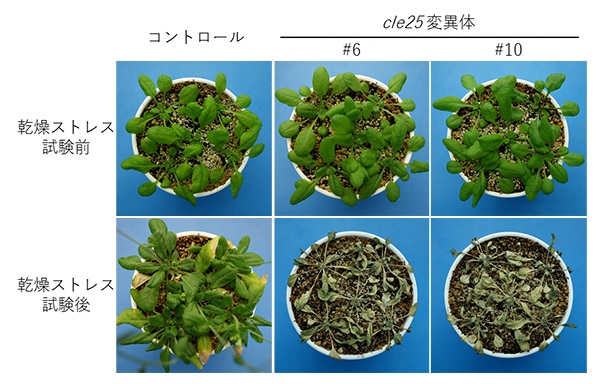News
Plant Peptide Resistant to Dehydration - Possibility to Cultivate Crops that Tolerate Dryness Updated in June 2018
A team consisting of RIKEN (Physical and Chemical Research Institute), University of Tokyo and Tokushima University has recently found a plant peptide that can resist dryness. The plant does not die easily even when it is placed under a dehydrating condition. This peptide helps to exchange information between the plant’s roots and the leaves to enhance resistance to droughts. Although global warming is expected to increase drought and dry areas, the group hopes that this research could help cultivate crops that are strong in dry conditions.
The joint research group consists of Fuminori Takahashi (Research Scientist, RIKEN’s CSRS-Center for Sustainable Resource Science, Gene Research Group), Kazuo Shinozaki (Group Director, RIKEN CSRS, Gene Research Group), Naoshi Domai (Unit Leader, RIKEN CSRS, Biomolecular Characterization Unit), Kazuko Yamaguchi-Shinozaki (Professor, University of Tokyo, Graduate School of Agricultural and Life Sciences), Hiroo Fukuda (Professor, University of Tokyo, Graduate School of Science) and Osakabe Yuriko (Associate Professor, Tokushima University Graduate School of Bioscience and Bioindustry).
Peptides are compounds formed by two or more amino acids and are active in living beings, including animals and plants. Takahashi made a cultured cell from Arabidopsis thaliana, a model plant that has been sequenced because the entire genome has been decoded. When applying stress similar to dehydration, a plant peptide called "CLE25 peptide" was released into the culture medium. In addition, the team artificially synthesized CLE25 peptides and gave them to the Arabidopsis plant and the synthesized peptides were absorbed by the plant root. Then, the CLE25 peptide moved to the leaf, and accumulated plant hormones that enhance tolerance to drought. This hormone which can withstand dryness is known as "abscisic acid" or ABA.
ABA is synthesized in plant leaves that have experienced stress from dehydration. It promotes the closure of stomata or pores on the leaf and prevents loss of water. The accumulation of ABA in leaves was caused by CLE25’s increased gene expression of enzymes that play a key role in ABA synthesis.
Next, the team used genome editing technology to create a new type of Arabidopsis thaliana, which is unable to form a CLE25 peptide, and examined its tolerance to droughts. It was found that ABA did not accumulate in the leaves and the plant could not stand dehydration. According to the group, it was not clear how ABA was synthesized after plants were exposed to dehydration stress resulting from lack of moisture in the soil. This time, when plants were dehydrated, the root cells release the CLE25 peptide into the plant duct. A signal which comes out when this peptide binds itself to the receptor, triggers the synthesis of ABA.
https://www.sciencedaily.com/releases/2018/04/180404133535.htm








